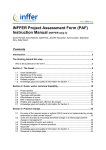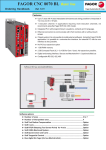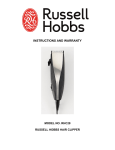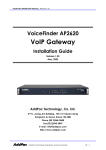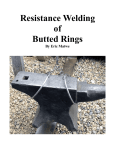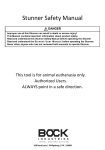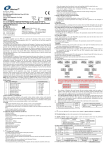Download HSSA Dog Handler Training Manual
Transcript
HSSA Dog Handler Training Manual A Resource for Volunteers at the Humane Society of Southern Arizona Revised 9.26.10 1 Table of Contents 1. Introduction to Dog Handling3 2. Dress Protocols..5 3. Safety...6 4. Working with Dogs: Safety, Disease Control, Accident Prevention...7 5. Procedures: Who, What, Where and When?.............11 6. Tools14 7. Dog Training..16 8. Dog Walking Mentors..................................................18 9. Can You Speak Dog?...19 2 Introduction to Dog Handling Job Description: Dog Handlers enjoy a great deal of physical contact with the dogs in the adoption area of HSSA and/or offsite locations and special events. The main goal of the volunteer Dog Handler is to make sure that dogs available for adoption get exercise, socialization, and learn some basic manners. Basic Duties Include: Walking dogs for both physical and mental exercise; socializing dogs; providing limited positive reinforcement training; and, when staff requests, taking dogs out of their kennels for potential adopters. Dog handlers at offsite locations and events will also interact with the public while handling dogs. Training Requirements: Successful completion of • • • Volunteer Orientation Dog Handler Class* Any additional requirements deemed necessary by our Volunteer Coordinator *Dog Handler mentors are also available for any new handlers that would like oneon-one attention during their first day working with the dogs. Emotional Considerations: Some of the animals you work with may be unadoptable, and therefore may be chosen for euthanasia. You must be able to focus on what you can do to make each animal you care for at the shelter as comfortable as possible. We ask that you provide as much loving care as possible during the dog’s stay here. Please show consideration to the shelter staff who are directly involved with this most difficult aspect of their job. Compassion fatigue workshops are available to volunteers on a regular basis. Don’t Forget To Sign In! Volunteers must always be sure to sign in at the beginning of their shift and sign out at the end of their shift. The sign-in sheet may be found at the volunteer area in the main hallway. Nametags must always be worn while you are on duty with HSSA. 3 Introduction to Dog Handling You Are a Big and Valued Part of HSSA! The time you spend with our shelter dogs can have a life-changing impact on them. It can also make the difference in finding them a loving forever home. Your assistance in working with the animals in the shelter is truly a worthwhile endeavor--it is greatly appreciated by the animals and by us! Taking a shelter dog out for a walk can be a challenging experience. Many of the dogs received in the shelter are lacking in basic social skills, and some have had little or no experience on a leash. Many are unaccustomed to--or are insecure around--other dogs, children, or people with whom they are not familiar. Even short amounts of time spent to help socialize and comfort these animals has a tremendous impact on their adoptability. It is important to read and understand the following guidelines to ensure that your time spent with the dogs will be enjoyable and beneficial for both you and the animals you care for in the shelter. If you have any questions or concerns that are not covered in this handbook, please see the Volunteer Coordinator for clarification. Important! Wash hands thoroughly with antibacterial soap or sanitize with gel between handling dogs from separate kennels. 4 Dress Protocols Please note: these guidelines have been developed to help prevent injury and disease spread. Neat, clean appearance reflecting positively on HSSA is required. Personal hygiene and cleanliness must be maintained at all times including minimal scents of perfume or cologne. Dog Handlers may not wear jewelry, necklaces, bracelets, earrings, facial jewelry, or scarves. Studs are permitted. (Dogs can get caught in them or accidentally break and/ or swallow them.) Please, no potentially offensive slogans or symbols, or clothing with political affiliations. All volunteers working in the shelter must wear nametags at all times while on duty. If you do not yet have a nametag, or if you should forget your nametag, please see the Volunteer Coordinator for a temporary one. Volunteers who work directly with animals in any capacity must wear closed-toed shoes. Rubber-soled shoes are strongly advised to prevent slipping in the kennel areas. Long pants are mandatory. Long-sleeved shirts/ blouses are advisable to prevent painful scratches. Pants that cover the entire leg are mandatory. Shirts and blouses should have full backs and conservative necklines. Management reserves the right to amend these dress and grooming guidelines when necessary to provide clarification. Please see the Volunteer Coordinator for HSSA Volunteer T-shirts. These are free after 40 hours of service, or $6.00-7.00 each if you wish to purchase them. Long-sleeved T-shirts may be available for order; please see the Volunteer Coordinator if you are interested. 5 Safety Volunteer safety at the HSSA is very important. The following information is shared to inform volunteers of the inherent dangers of working with shelter animals. While the following guidelines will protect volunteers in many situations, it is paramount that volunteers also rely upon sound personal judgment while working and communicating with our canine charges; if it feels or looks wrong, it probably is. Always err on the side of caution when working with shelter animals. Zoonotic diseases: Zoonotic diseases are those diseases which are transmissible from animals to humans or other species. Due to the large number of animals we interact with here at a shelter, risk of contracting zoonotic disease increases in this environment. Please follow the guidelines below to help limit your exposure to zoonotic diseases while you volunteer as a dog handler: Report any bites or injuries immediately to staff/ the Volunteer Coordinator. Stay current on appropriate vaccinations, such as tetanus. Wash your hands frequently with antibacterial soap (or sanitize with antibacterial gel), especially prior to eating or smoking. You should also do this between handling dogs from different kennels. Wear long pants and sturdy shoes or boots. Use gloves when cleaning up feces, urine or vomit. Disinfect scratches and bites immediately. Please let us know if you see signs of infection (redness, swelling, pain, etc.). Report bites after disinfecting. Please bring potential signs of canine disease to the immediate attention of a staff member. This could include: hair loss, discharge from the nose or eyes, lethargy, vomiting or diarrhea. Avoid hanging leashes/leads around your neck; these can carry disease. It is a good idea to change clothes after you have had a great deal of physical interaction with shelter animals. Seek assistance when handling animals whose dispositions are questionable. Inform your physician that you work closely with animals, and visit him or her regularly. 6 Working with Dogs Safety Disease Control Accident Prevention Safe Steps to take when walking dogs in our shelter: • Stay clean. Remember to protect yourself and other animals: please wash your hands or use the antibacterial lotion in between handling dogs from different kennels. • Read the kennel card. It is very important to read and interpret all information on the dog’s kennel card before going into any kennel. Never work with a dog that makes you feel uncomfortable. • Read the dog. Meet the dog from the outside of the kennel first to evaluate its behavior. Take note of the dog’s name, and use it while speaking to it in a soothing voice. If any dog gives even the slightest hint of being aggressive, or if you are uncertain of what the animal is communicating, do not enter the kennel. If the dog appears to be friendly, proceed into the kennel. Throughout your time with the dog, look at what the animal is communicating. • Don’t get caught. Always keep yourself between the dog and the kennel door. • Evaluate kennels with more than one dog. o If you have more than one dog in a kennel and they are very excited or active, you may need to separate them before entering or exiting the kennel. Watch the dogs for a few minutes, and close the sliding (guillotine) door while the dog you want is inside and its kennelmate is outside. Before attempting to get any dog out of a kennel, be certain that the exterior dog adoption kennel doors are shut to prevent dogs from escaping. o Dog escapes do happen from individual kennels. This is especially true when you attempt to remove a single dog from a kennel with kennelmates. Always ask for assistance if you are concerned about escape. o Nice dogs can get over-excited and/or competitive when a walk is involved. Never attempt to work with a dog that is kennel fighting--get help immediately. • Dog Handlers may only walk one dog at a time. You may team up with another HSSA Dog Handler to walk two dogs if they are from the same kennel. If walking with a buddy, be sure to keep a safe distance from each other so the dogs don’t become tangled up. 7 Working with Dogs Safety Disease Control Accident Prevention • Some dogs cannot be walked by some handlers. Please know your limits in relation to the dog’s size and energy level, and don’t try to exceed those limits. If a dog proves to be more than you can handle, please place it back in its kennel. • Move quickly and safely through the dog runs. Once a dog has been removed from its kennel, move as quickly as possible to the closest exit. o o o o o o If you are removing an animal from an exterior kennel, make certain that all back gates are shut prior to entering the kennel. If a guillotine door is shut, do not open it. The outside gate may be open. Don’t let your dog stop to sniff or visit with other dogs or people while you are in the kennels or near the dog walking station. If your dog begins to kennel fight, immediately push the dog forward and away from the kennel gate; pulling a kennel fighting dog towards yourself may result in you being bitten. Only kennel mates should be in the dog walking station at the same time. Please clean up any urination marking dogs make while inside the buildings • Never drag a dog by the leash! If the dog refuses to leave the kennel, you may want to spend extra time in the kennel to make him feel more comfortable leaving with you, or you may carry him to an exercise yard. If you need help moving a scared or stubborn dog, simply ask a volunteer or staff member. • Never make unnecessary noise in our kennels. The dogs here experience a great deal of noise-related stress, especially during walking and feeding times. Please do not add to this stress by raising your voice, yelling at the animals, or banging on kennel doors. The one exception to this rule is if two dogs are fighting; we then attempt to distract them with noise. • Be aware of your human body language. Just as dogs communicate to humans with their bodies, humans relay information to dogs with our bodies. It is important that dog handlers have confidence when approaching the dogs. Dogs can see, hear, smell and otherwise sense subtle changes in your body language and biochemistry. If you are not confident, the dog may react negatively. The following tools will assist you in communicating a confident and friendly body language to the dogs: Bend down at the knees when greeting dogs. Face the dog from the side rather than having your chest toward him. Extend your hand to the dog for a sniff. Speak to the dog in a normal, reassuring voice. If the dog rolls over or does not immediately approach you, have patience. Wait for the dog to come to the gate and smell your hand. 8 Working with Dogs Safety Disease Control Accident Prevention Dogs and humans can run into a few communication problems along the way. Listed below are some human body language positions that dogs may interpret as threats: Please do not5 Bend over at the hips to work with a dog. Hug or kiss shelter dogs. Move quickly/exhibit jerky movements with the dogs. Stare at the dogs. Stop paying attention to the animal you are working with. Shout commands (or anything else) at the dog. How to Deal with a Dog Fight: Dog fights are a normal aspect of canine social interactions. To prevent undue harm, please protect yourself first and then end the fight quickly. Whether you are inside the kennels or outdoors, never attempt to break up a fight with your hands. • Indoors. If a fight breaks out in a dog run: o Immediately exit the run. If you are trapped by two fighting dogs, stand as far away from the dogs as possible and yell “stop” or “no” in a deep, loud voice until they stop fighting or until staff arrive to assist you. o If you are outside of the kennel and dogs are fighting, attempt to distract them by kicking the gate with the bottom of your foot while yelling “stop” or “no” in a deep, loud voice. o If all attempts to break up the fight fail, quickly find a shelter employee for help. After a dog fight is ended, report the information to an HSSA employee. We may wish to find new kennelmates! • Outdoors in the yard. fighting in a yard: If you are present when two kennelmates begin o Attempt to distract using noise, as in the kennel situation. o There are hoses available in the yard. You may attempt to break up a fight by spraying a dog in the mouth region. 9 Working with Dogs Safety Disease Control Accident Prevention o There are also alarms in our play yards. Please ring the alarm immediately for staff assistance in breaking up a fight. o Remove yourself from the vicinity of the fighting dogs. Never place your hands in between two fighting dogs. • Outdoors on a walk. Dog fights that erupt during a walk are very rare. o With proper control of the leash, your dog should never come into direct contact with another dog. If an off-leash dog approaches you, walk in the opposite direction while talking positively to your animal. If the dog continues to approach you, raise your hands above your head and yell “go” to the approaching animal. o If the dog you are walking is attacked, attempt to distract the dogs by yelling, as in the kennel situation. If this doesn’t work, you may send someone else to get help from staff, or you may attempt to pull your dog from the situation using the leash. Once again, never place your hands in between two fighting dogs. Safely Giving Dog Treats: Sharing treats with dogs can be very rewarding, but remember it can also motivate dogs to fight. Dog treats should only be given to dogs that are outside of the kennels. These dogs should be far enough away from other dogs that they will not be bothered while chewing on the treat. Dog treats should never be given to dogs in the kennels. This is a quick way to start a dog fight. Treats can be found in the dog walking closet as well as the adoption lobby. Please close the treat containers to deter our wild rodent and cockroach population. Feed only a limited amount of dog treats and only after 8:00 AM in case they are scheduled for surgery (please no people food). Please note: we avoid deep red dyes in our treats to avoid the appearance of blood in the stool. If You Have an Ill or Injured Animal: If an animal is presenting a sign of illness or injury, please inform shelter staff immediately. You should always report: • • • • Cold symptoms: coughing, sneezing, or nasal discharge Signs of injury: limping, bleeding, etc. Parasites: fleas, ticks, worms in stool Other concerns: explosive diarrhea, vomiting, uncharacteristic lethargy, etc. 10 Procedures: Who, What, Where and When? Who Can Walk Dogs? We have established the following age guidelines for safety and liability purposes: • • • • • Children under 10 are not able to volunteer in our shelter environment. Children under 15 cannot hold leashes or take dogs in and out of kennels. These children are a major component of the HSSA’s volunteer program. While we encourage the very beneficial social interactions of children with shelter dogs, we do need to provide adequate protection for both kids and canines. This creates a few challenges. To meet these challenges, the HSSA asks that all children under 15 be accompanied by a certified parent or certified adult dog handler 18 or over at all times. We require that the adult, only, removes the animal from the kennel, and the adult, only, holds the end of the leash at all times. Kids are expected to have fun. Teens 15-17 can walk dogs autonomously. They cannot, however, walk certain breeds: Pitbulls, Rottweilers, Mastiffs, Dobermans, and Great Danes. Adults 18 and over with under 20 hours of dog handler experience can walk dogs autonomously, however they cannot walk certain breeds: Pitbulls, Rottweilers, Mastiffs, Dobermans, and Great Danes. Adults 18 and over with 20 or more hours of dog handling experience can walk dogs of all breeds autonomously, however we ask that you be aware of your own physical limitations in dealing with specific animals. Please avoid handling dogs that you do not feel comfortable controlling. What Dogs Can I Walk? Adoption Dogs Only. Only the dogs from the Adoption kennels may be handled and walked. Stray-kennel dogs have not yet been evaluated to identify their health and temperament, and thus they are not to be handled by volunteers. Moreover, stray-kennel dogs are not (and may not become) available for adoption; HSSA adoption customers are not permitted in the stray kennels. Important: Please do NOT walk dogs that are going to an offsite location for the day. These dogs will have their regular kennel cards removed; in place of the kennel card, you will find a laminated sign reading that the dog will be at an offsite location. These dogs should NOT be removed from their kennels. 11 Procedures: Who, What, Where and When? Where to Walk Dogs? Adult dogs (five months of age and up) may be walked on the streets and along the wash trail. Please be courteous to our neighbors; do not let shelter dogs enter or soil any yard or driveway. If a dog defecates while on a walk, immediately pick it up using the plastic bags provided. Puppies (eight weeks to five months of age) are not yet fully vaccinated, nor are their immune systems fully developed. Therefore, we ask that puppies up to 5 months are not removed from their kennels by volunteers. If puppies have been here for an extended period of time, shelter staff may request that you take the puppy to a specified visitation yard called Tucker’s Place. Important: To prevent disease spread, volunteers are not permitted to sit in the kennels with puppies or dogs. Volunteers may bend down to try to make a dog more comfortable, and/or to coax a dog out for a walk. The Yards: There are two different yards for use by HSSA dogs. These can be used by the public/adoption staff as well as by volunteers. • • The Large Visitation Yard has entry and exit gates on either side, so other leashed dogs may need to walk through this area. Be sure to check if the yard is in use before walking through with a dog. If you are using this yard, be sure your dog is on a leash, as the gates are opened frequently by staff and other volunteers. Volunteers may use this yard when it is not in use by the public/adoption staff. The Small Visitation Yard has a single entry gate and does not have through traffic. Therefore, dogs who are not at risk of jumping the fence may play here unleashed. Only one dog is permitted in this space if it is off-lead. If two dogs are in this area, they should both be on a lead. Dogs should never be left unattended in these yards or anywhere else at HSSA, besides, of course, their kennels. 12 Procedures: Who, What, Where and When? When Can I Walk Dogs? Dog walking hours vary depending on the season. Typically, the hours are 6 am – 6 pm Monday–Saturday and 6 am – 5 pm on Sundays. During the winter, the start time will be 7 am (it is too dark before then). Inexperienced dog walkers with fewer than 20 hours of dog handling should walk dogs closer to 8 am to ensure staff/volunteer assistance if available if necessary. Staff will unlock the kennel door’s deadbolts. The first volunteer at the facility is responsible for entering the facility through the unlocked employee entrance and unlocking the doorknob locks from the inside. Volunteers must following these temperature guidelines for walking dogs: • • • 85-95°F. Whenever temperatures exceed 85 ْ◌F dogs cannot cool themselves properly. Limit walks at or above these temperatures to five minutes. You can still spend some time socializing them in the visitation yard, but pay attention to the animal. If a dog is panting excessively, lies down and refuses to move, becomes disoriented or acts clumsy, please get it inside the kennels immediately and bring the situation to the attention of a shelter staff member. Over 95°F. During June, July and August, dog walking and visits will be severely limited due to extreme temperatures. Dogs should never be walked if the air temperature is above 95 ْ◌ F. On most days, dogs will have to stay inside their kennels after 10:00 AM. Please use good judgment: refrain from walking dogs in any extreme weather condition. With hot temperatures, also pay attention to the dog’s paws. Asphalt temperatures can exceed 130 ْ◌ F if the ambient temperature is 90 ْ◌ F. This can severely injure a dog. For the safety of the dog, always move quickly to get the dog off of concrete or asphalt during hot weather. Use the wash trail during hotter times of the day or year, and stay in the shade of the trees along the path. Please be aware that if you come during the feeding hours, you cannot walk dogs if they are eating, or up to twenty minutes afterward. If you return and there is food in the kennel, or if the guillotine door has been shut, please find a staff member to assist you in placing the dog in the kennel. 13 Tools Training collars, leashes, small dog harnesses, and other supplies • • • • • • • • • • • These are located in the dog walker’s closet. Be sure the collar and leash you choose is appropriate and the correct size for each dog. Most dog walkers will use training collars and leashes. Training collars are used to keep the dog securely at the end of the leash; never administer “corrections” with an HSSA dog. Very small dogs should be fitted with a harness rather than a training collar. Be sure that you know how to fit the harness, or ask for assistance. A kennel key may be obtained from an adoption counselor. After 20 hours of service, dog handler volunteers may request their own dog key from the Volunteer Coordinator. Dogs may be removed from their kennels using either a training collar or a nylon slip lead. If a slip lead is being used, make certain to switch it to a training collar and leash prior to leaving the shelter area. Never walk a dog on a slip lead. Never use a buckle collar when walking dogs. When sizing a training collar, there should be at least two inches of slack when slipping the collar over the dog’s head; otherwise the collar may get stuck on the dog’s head. Please do not walk dogs using a chain leash, as it is difficult to control an active dog with a chain. It is critical to clean-up any mess a dog leaves behind. Please carry along a plastic pooh bag when you take a dog for a walk. Due to possible health complications, please do not run or jog with any of the dogs. Take special note of the dog’s kennel number so that you will always return the dog back to its correct kennel. You MUST put an OUT FOR A WALK sign on the kennel card so staff and potential adopters know where the dog is at all times. o Do not walk puppies under 5 months o Do not walk adopted dogs o Do not walk dogs scheduled to go offsite for the day (kennels will be labeled) Warning! This Collar Can Kill Your Dog! The training collar, or “choke chain,” is not a proper dog collar and should never be used as one. Don’t ever leave the training collar on an unsupervised dog. Accidents do happen. It is a tragic sight to find your beloved pet hanging dead from the fence because the slip collar got caught on a prong, bolt or nail. It is just as easy for him to get hung up on a bush, shrub or other unsuspecting thing, and in a frantic effort to free himself, the slip collar becomes a death trap. The only collar that should be left on a dog is one with a buckle; it is to this collar that you attach your dog’s identification and license tags. 14 Tools Dog Walker’s Closet/ The White Board The dog walker’s closet is located just outside of the back door of the adoption kennels. It is there to provide you with all necessary dog walking tools as well as to help our dog handler volunteers communicate with each other. The closet includes: • Choke chains • Leashes • Harnesses for small or special needs dogs • Slip leads • Treats • A Hanging Thermometer • Pooh Bags • Generic Volunteer Name Badges • Out for a Walk Signs • White Board o One white board serves as a message board for the Volunteers and the Volunteer Coordinator to communicate. Please read this each time you arrive to walk dogs. It may be updated with new policies/procedures, or it may include important information on a specific dog. o Two white boards are to allow dog walkers to communicate which dogs have been walked, and when. The boards have kennel number, name of dogs, and day of the month the dog was last walked. Many are also marked “housebroken” or “clinic” It is helpful to walk the housebroken dogs first. However, if you are uncomfortable with the breed, strength, or behavior of a specific dog, please refrain from walking it. After housebroken dogs, most dog walkers try to walk dogs who have not yet been walked on that day. Once you do walk a dog, please update the date of the walk to let others know. Again, if you are uncomfortable with the breed, strength, or behavior of a specific dog, please refrain from walking it. Dogs at the clinic are either absent or soon to leave for surgery. Please refrain from walking these dogs. Even if they are listed on the white board, please do not walk adopted dogs or dogs marked to go offsite. You will know this because the dog will not have a kennel card on its kennel. 15 Dog Training The HSSA uses positive reinforcement training techniques to gently guide dogs to perform desired behaviors. This training style improves an animal’s confidence in people, motivates the animal to work, challenges the animal without fear and, if performed properly, can be a very quick way for an animal to learn a new behavior. Positive Reinforcement is very simple to use as long as a few guidelines are followed at all times: ☺ Consistency. All people that work with the dog must follow the same training style and be consistent with the language used. Beginning Handlers will only be using the “sit” and “off” commands. “Sit” will tell a dog to place his or her butt on the ground. The “off” command will be used to tell the dog that all four paws should be touching the ground. ☺ Positive reinforcement. Each time dogs perform a desired behavior, we will reward them with the phrase “good dog” and a treat them. If the dog fails at the desired behavior, do not reward it. ☺ Practice. If the dog does not know the desired behavior, we will shape it by rewarding progressive steps toward the desired behavior. ☺ Timing. Proper timing is one of the most important aspects of positive reinforcement training. Dogs must be rewarded with praise (“good dog”/treat) within three seconds. A dog’s attention may only last for around three seconds, so if he is rewarded after three seconds, you are actually rewarding something else. ☺ Patience. If you become frustrated, immediately stop training. The change in your body language may confuse the dog. Ask the Volunteer Coordinator or your Dog Handler Class Instructor if you have any questions. Protocols are in place to protect volunteers and the lives of our animals! 16 Dog Training Training Commands: Off & Sit OFF The “off” command informs the dog that all four paws should be on the floor. “Off” is usually used when a dog has jumped up with its front paws onto a person, or when it is on the furniture. For consistency with our training we will all use the following procedures to train a dog to follow the “off” command: 1. When a dog jumps up on you with its paws, pull your hands close to your body and turn away from it while saying “off.” 2. When the dog has all four paws on the ground, turn, praise it with “good dog” and give it a treat. 3. If the dog jumps up again, follow steps number one and two. 4. If the dog knows the “sit” command, after the dog gets down praise it with “good dog,” then ask it to “sit.” When it sits, reward the dog with “good dog” and a treat. Oftentimes, people end up inadvertently rewarding a dog that jumps up by touching it, talking to it and looking at it. Whether you are pushing a dog down, yelling at it to “Stay Back” or looking at it with scorn, it is receiving attention and thus being rewarded. Dogs that are yearning for attention, including shelter dogs, will take anything they get. Please do not unintentionally reward a dog showing undesirable behavior. Pull in your arms and turn your back instead. SIT The command “sit” informs the dog that it should have its butt on the ground. For consistency with our training, we will all use the following procedures to train a dog to follow the “sit” command: 1. Take a small bit of treat and hold it slightly above and in front of the dog’s head. 2. Begin moving your hand towards the rear of the dog and say “sit.” The dog should follow the treat until it is forced to place its butt on the ground to continue to see the treat. 3. Immediately give the treat to the dog when the butt hits the ground, and praise it saying, “good sit.” If the dog stands up don’t treat it; it will think it is being rewarded for standing up. 4. If it crouches back instead of sitting, treat it and, next time, require it to go further or fully sit. This is called shaping. 5. If the dog jumps up, say “uh-oh”, then attempt step (1) again. Sometimes if the hand is too far above the dog, it will jump up instead of following the treat. Lower your hand so that you are just above the dogs muzzle and skull. 6. If the dog backs up instead of sitting down, attempt steps (1) to (3) with the dog’s back towards a wall or solid object, so it can not back up further. NEVER attempt to teach a dog to sit by pushing on his hind end. This is NOT positive reinforcement training. Moreover, it can cause potential physical damage to the dog’s spine, hips, and/or legs. Please do not attempt to train a dog to sit in a busy area. An untrained dog has a very short attention span. If there are a lot of distractions like other dogs, people, and cars around, the dog may not be able to pay attention long enough to learn the command. Find a quite place along the river trail or in between traffic on the roads. Be patient and have fun. This will assist the dog greatly. 17 Dog Walking Mentors Excited about volunteering to walk dogs at the Humane Society, but not too sure how to go about actually doing it? Never Fear: Dog Walking Mentors Are Here! The HSSA Dog Walking Mentor Program matches new volunteers with experienced dog walkers. New volunteers get hands-on experience as the mentors take you through dog walking from start to finish. The HSSA highly encourages our volunteers to take advantage of this resource. You may meet with the mentor as many times as necessary. Most people feel comfortable after just one session, but you are welcome to have as many as you like. Two mentoring methods are available: 1) Schedule an appointment with a mentor. To set up an appointment with a dog walking mentor, please contact the Volunteer Coordinator. Phone: 321-3704, ext. 126 Email: [email protected] 2) Meet with our resident mentor, available every Wednesday at 9:00 a.m. and the first Saturday of the month at 9:00 a.m. No appointment necessary. Simply come to the outside gate by the dog walkers’ closet and meet with the mentor. 18






















